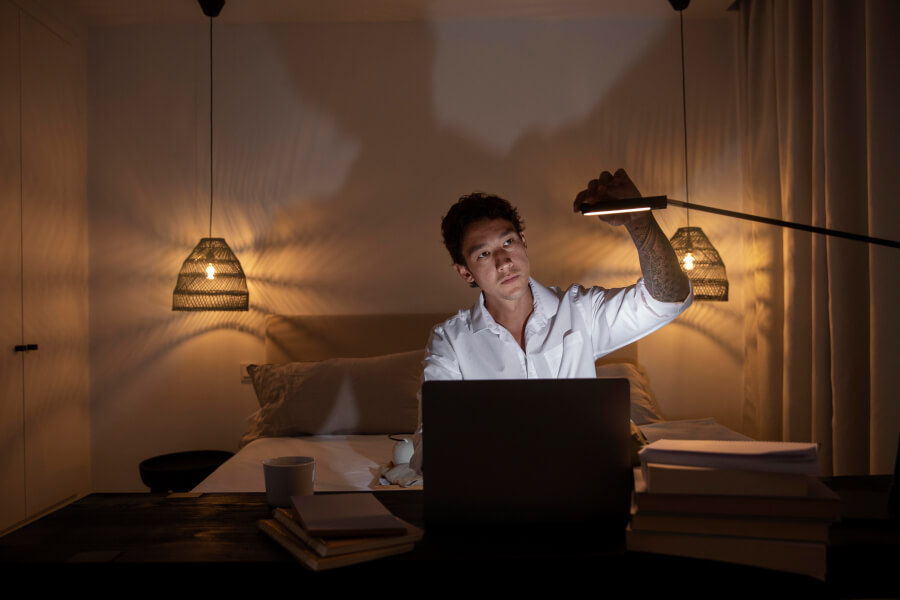Night owls beware: your late-night habits may come with hidden risks, including a higher likelihood of developing diabetes type 2.
Let’s explore the connection between sleep patterns and diabetes, unraveling the science behind sleep cycles and their impact on your health.
Whether you’re a dedicated night owl or someone simply curious about the topic, keep reading to discover how your sleep routine could be affecting your long-term wellness and what you can do about it.
Do Night Owls Have a Higher Risk of Diabetes Type 2?
Many people prefer staying up late, whether due to work schedules, social activities, or personal preference. However, research increasingly shows that being a “night owl” isn’t just a matter of personal choice, it may have serious implications for your health, especially concerning diabetes type 2.
Diabetes type 2 is a chronic condition that affects how your body processes blood sugar (glucose). In people with diabetes type 2, the body either doesn’t produce enough insulin or the cells resist the effects of insulin, which is a horm
one that helps glucose enter the cells to be used for energy.
Key Points about Diabetes type 2:
- Insulin Resistance
- Insulin Deficiency
- High Blood Sugar
What Being a Night Owl Means for Your Health
So, what exactly does it mean to be a night owl? A “chronotype” is a natural preference for when we sleep and wake.
Night owls tend to feel more alert and productive in the evening, often staying up late into the night and waking up later in the morning.
While this may seem harmless, such a routine often disrupts the body’s natural circadian rhythms.
How Being a Night Owl Affects Your Sleep and Wellness
Circadian rhythms are the body’s internal clock that regulates sleep-wake cycles, hormone release, digestion, and other functions. When these rhythms are thrown off balance, it can negatively impact our health in several ways, like:
- Disrupted Circadian Rhythm
- Increased Risk of Chronic Conditions
- Impaired Cognitive Function
- Mood Disorders
- Weakened Immune System
- Unhealthy Lifestyle Habits
- Hormonal Imbalance
The Link Between Your Body Clock and Type 2 Diabetes
Some people are genetically predisposed to being night owls, while others may fall into this sleep pattern due to lifestyle choices. Regardless of the cause, late-night habits disrupt the body’s circadian rhythm. This disruption can lead to metabolic changes, decreased insulin sensitivity, and increased blood sugar levels, factors closely linked to type 2 diabetes.
Research Findings on the Increased Risk for Night Owls
Several studies have examined the relationship between night owls and an increased risk of diabetes type 2.
For example, a study published in Diabetes 2 Care found that individuals with late-night chronotypes were more likely to develop metabolic disorders, including diabetes. This correlation is primarily due to misalignment between the body’s internal clock and external cues, such as light exposure and meal timing.
Impact of Unusual Sleep Patterns on Insulin Resistance
Sleep plays a crucial role in maintaining healthy blood sugar levels. Night owls often get less sleep or poorer-quality sleep, both of which can contribute to insulin resistance which is a key factor in the development of type 2 diabetes. Irregular sleep schedules and chronic sleep deprivation increase stress hormones like cortisol, which further impairs the body’s ability to regulate blood sugar.
Lower Insulin Sensitivity
- Decreased Effectiveness: Poor sleep reduces how well your body responds to insulin, causing higher blood sugar levels as more insulin is needed to manage glucose.
Impaired Glucose Processing
- Higher Blood Sugar: Irregular sleep can make it harder for your body to process glucose, leading to increased blood sugar levels and a higher risk of insulin resistance.
Weight Gain
- Increased Hunger: Lack of sleep affects hunger hormones, leading to overeating and weight gain. Extra weight, especially around the abdomen, worsens insulin resistance.
Disrupted Circadian Rhythm
- Metabolic Disruption: Poor sleep messes with your body’s internal clock, affecting how well your body regulates blood sugar and insulin.
Less Physical Activity
- Reduced Exercise: Fatigue from poor sleep can decrease motivation to exercise. Less physical activity can worsen insulin resistance.
Elevated Stress Hormones
- More Cortisol: Chronic sleep disruption can increase cortisol levels, which interferes with insulin and glucose management.
To help manage insulin resistance, aim for regular, quality sleep. Good sleep habits, like sticking to a schedule and reducing stress, can support better blood sugar control and overall health.
Lifestyle Factors Contributing to Diabetes 2 Risk
Late-Night Eating Impact on Blood Sugar Levels
Late-night eating is a common habit among night owls, and it poses another significant risk for diabetes. Eating late at night can interfere with the body’s ability to process glucose effectively. The digestive system is less active during the evening, and this reduced metabolic efficiency can lead to higher blood sugar levels after meals, making it harder for the body to maintain balance.
Night owls also tend to snack on unhealthy, high-carb, and sugary foods, further exacerbating the risk of insulin resistance.
Physical Activity Levels in Night Owls
Another issue is that night owls may be less likely to engage in regular physical activity. Early risers often take advantage of the morning for exercise, while night owls might find it difficult to maintain an active routine due to time constraints or fatigue during the day. A sedentary lifestyle increases the likelihood of weight gain, another risk factor for diabetes type 2.
Managing Diabetes 2 Risk as a Night Owl
If you’re a night owl, it’s not all doom and gloom. There are several strategies you can adopt to help mitigate your risk of developing diabetes type 2.
Sleep Hygiene Tips for Improving Sleep Quality
Start by improving your sleep hygiene. Setting a regular bedtime and wake-up time – even on weekends – can help reset your circadian rhythm. Make your bedroom a sleep-friendly environment by keeping it cool, dark, and quiet. Limiting exposure to screens before bed and creating a relaxing pre-sleep routine, such as reading or meditation, can also improve your sleep quality.
Diet Tips for Night Owls to Lower Diabetes Risk
Night owls should be mindful of their eating habits, especially late at night. Avoid consuming large, high-carb meals close to bedtime, as this can spike blood sugar levels. Instead, go for smaller, balanced meals earlier in the evening. Incorporating foods that promote steady blood sugar levels, such as lean proteins, whole grains, and vegetables, can help keep glucose levels in check.
Exercise Tips for Night Owls: Staying Active at Night
Physical activity is another important factor. Find a time during the day that works for you to incorporate regular exercise. Whether it’s a brisk walk, yoga session, or weight training, staying active helps improve insulin sensitivity and supports overall metabolic health. Even light activity, such as stretching or short bursts of exercise throughout the day, can have a positive impact.
Conclusion
Being a night owl may feel like part of your identity, but it comes with health risks that shouldn’t be ignored, especially when it comes to type 2 diabetes. Disrupted circadian rhythms, poor sleep quality, unhealthy eating habits, and sedentary lifestyles are all contributors to this increased risk. By making small yet significant lifestyle changes, night owls can reduce their chances of developing diabetes type 2 and improve their overall well-being.
FAQs
Are night owls more likely to develop diabetes?
Yes, research has shown that night owls have a higher risk of developing type 2 diabetes due to disrupted sleep patterns and associated lifestyle factors.
Do night owls have more health problems?
Night owls tend to have an increased risk of several health issues, including obesity, heart disease, and metabolic disorders like diabetes.
What are the downsides of being a night owl?
Beyond the risk of diabetes, being a night owl can lead to chronic sleep deprivation, poor mental health, and difficulty maintaining a healthy lifestyle.
Do night owls have a higher risk of dying sooner?
Studies suggest that night owls may have a slightly higher risk of premature death due to the long-term effects of chronic sleep disruption and unhealthy lifestyle habits.








